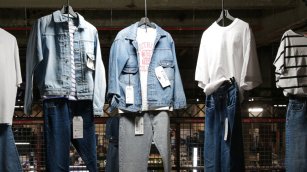Raffaello Napoleone (Pitti Uomo): “This is a pivotal moment to reframe the future of fashion”
The CEO of the Florentine menswear fair analyzes the context of “perfect storm” with optimism, highlighting the need for reinvention and the resilience of a sector expert in surviving crises.


The CEO of Pitti Immagine Uomo analyzes the evolution of men's fashion from Florence, in full celebration of the fair in an uncertain global context. In conversation with Modaes, Napoleone claims the resilient role of the sector and defends the capacity of the Italian model to adapt with agility to the new codes of consumption and retail. Faced with what he describes as a "perfect storm", the executive is committed to consolidating local know-how, opening up to new markets such as Indonesia and strengthening the links between culture, industry and sustainability.
Question: This season seems to mark a turning point for the fair. How do you experience it from your position as a manager?
Answer: We have to say it clearly: we are going through one of the most complex crises since World War II. We have lived through a pandemic, there is an ongoing war, an energy crisis, logistical problems and an environment of unprecedented uncertainty in the economy and geopolitics. In addition, something unprecedented: there is no world leadership. I do not want to single anyone out, but there is no figure or country leading the system as in the past there might have been the United States, Germany or the United Kingdom. And that complicates everything. Fashion, as always, is the most sensitive thermometer, because it is a necessary, daily and deeply cultural good.
Q.: Is that sensitivity also reflected in the way we dress and shop?
A.: Yes, absolutely. Lifestyle has changed. Today we talk a lot about wellness, but not only wellness in physical terms. It has to do with how we move, how we live. Let's look at the bicycle, at the center of this issue. Today you can rent one in any city with a card. The same with scooters. That changes how we dress. We need performance, functional, lightweight, adaptable clothing. Aesthetics are not enough. We see it in footwear as well, with sneakers replacing classic shoes. Fashion must respond to this pace of life. In the past, there was a clear separation between formal and functional. Today, even classic fabrics are adapting.
Q.: And this transformation is present in the salons?
A.: Of course. You only have to walk around the central pavilion of Pitti Uomo to see how everything has evolved towards performance. Streetwear continues to grow. We might have thought it was a passing trend, but it has become consolidated.
Q.: For years it has been said that it was the end of the salons or the multi-brand. How does the sector continue to survive?
A.: Yes, it has been said many times that everything was coming to an end: salons, multi-brand stores, even local production. But fashion is a resilient system. We are in a good moment to reconfigure the fashion system. In Italy we have a model of small and medium-sized companies, very specialized, with industrial districts that allow us to adapt quickly. That is a strength, even if financially it is a fragility. Many of these companies produce for major brands and also maintain their own lines that barely exceed 1.5 million euros, but which guarantee their sustainability. They are family structures, with employees who have dedicated their lives to their work, without luxuries or excesses. They must be protected, with guarantees, to preserve their know-how.
Q.: Do you see solutions like Gruppo Florence as a model to follow?
A.: Without a doubt. They have managed to merge different companies in three years, reach 700 employees, maintain ownership and gain financial capacity. We also see groups like Prada or Brunello Cucinelli taking stakes in key companies, ensuring continuity without intervening in management. There is a lot of movement in Italy now. The priority is to avoid losing industrial capabilities due to lack of support or financing.
Q.: How are Made in Italy affected by the controversies regarding subcontractors in the supply chain?
A.: There are specific cases that need to be controlled, but the system is mostly legal. More than 90% of the companies comply with the regulations. In addition, many workers are second or third generation immigrants, fully integrated. Integration is necessary, especially in a country like Italy, where the birth rate has fallen to worrying levels. We are below the replacement threshold. Without immigration and integration, the system cannot be sustained.
Q.: Do you think the prestige of Made in Italy is at risk or can it continue to compete?
A.: No. The data are clear. The problematic cases are a minority. In Italy there is a solid regulatory framework. And besides, Italian fashion has an enormous cultural and economic weight. We should not get carried away by sensationalist headlines. We have to look at the percentages. The vast majority work well.
Q.: What is the general feeling among the brands participating in Pitti?
A.: There is concern, of course. But there is also confidence. What dominates is uncertainty. But the real economy still exists. What has changed profoundly is distribution and the rise of second-hand. Chanel has already launched its circular platform. The second-hand market will reach €150 billion by 2024 and is forecast to reach €350 billion by 2028. In Italy, fashion remains a driving force: €98 billion in turnover in 2024. And the second-hand market already represents almost half of the sector by volume.
"The real economy still exists. What has changed profoundly is distribution and the rise of second-hand"
Q.: Is it a cultural change?
A.: Absolutely. I have a 17-year-old daughter. She sells some sneakers and buys others. It's not the logic of my generation, which aspired to a specific brand or product. Today there is more rotation, more exchange. Each generation has gone through its own transformation. Before, change cycles were 25 years. Now, every 10 or 15 years there is a total renewal of the system. You have to understand it and adapt.
Q.: How are brands dealing with the upward trend of focusing on opening physical stores and less on wholesale?
A.: Large locations like Via Montenapoleone or Madison Avenue are expensive, yes, but there are many other secondary areas that work very well. It's a matter of finding the right location for each product and for each brand. Not everything is luxury or flagship. There are very effective in-between formats.
Q.: Which markets are growing strongly in the case of Pitti Uomo?
A.: South Korea is key. We have always worked with China and Japan, but now we are very focused on Korea, even with a permanent presence. There are also emerging markets such as Thailand, Vietnam and Indonesia. I was recently at fashion week in Jakarta and I saw department stores on a par with New York or Paris, although still focused on big brands. There is huge room for growth there. Indonesia has 450 million inhabitants. You have to be there.
Q.: And where is Spain?
A.: Spain is moving well. Zara and Mango export a lot. In terms of trade with Italy, it is one of the first trading partners. At Pitti, we also have an event dedicated to Spanish brands in collaboration with Icex, which we want to continue developing. We have been collaborating for years with Japan, China, and more recently with young Chinese creators. We also work with platforms or initiatives with Ukraine. It is important to be open to new ideas from different markets.
Q.: How do you see the evolution of Pitti Bimbo and the children's segment?
A.: The channel has changed drastically. Today, 60% of distribution is in the hands of large chains. I have seven grandchildren, and their parents buy organic cotton polo shirts at Uniqlo for 8 or 12 euros, for example. It is difficult to compete with that. The challenge is to adapt to a distribution system that has changed.
Q.: France has passed a law against fast fashion, especially against Shein, one of the players that has the most pressure in the child-teenage segment. What do you think about following the Italian example?
A.: I'm not so much concerned about fast fashion as about the environmental impact of certain production models. What we have to fight against is unethical, poorly paid production, which also harms the environment. That is serious. The rest is part of the market, it has always existed.













